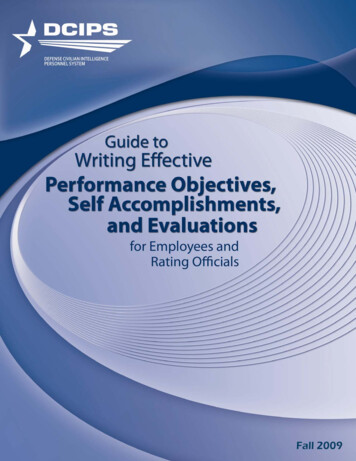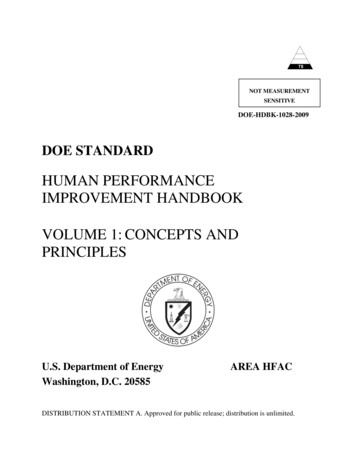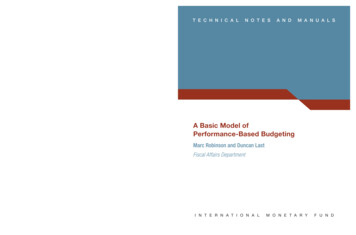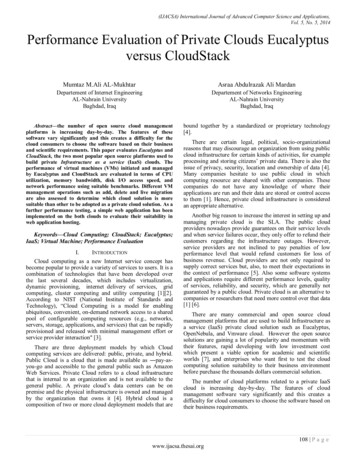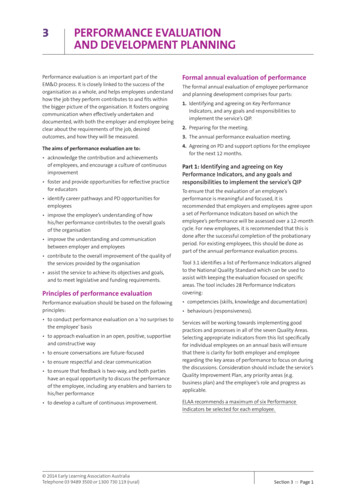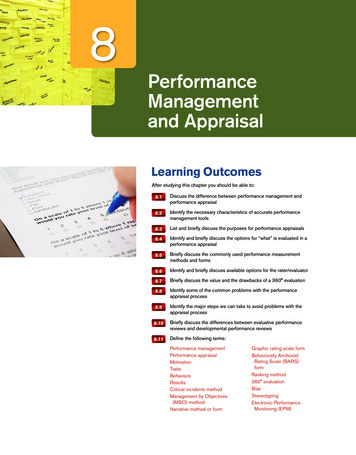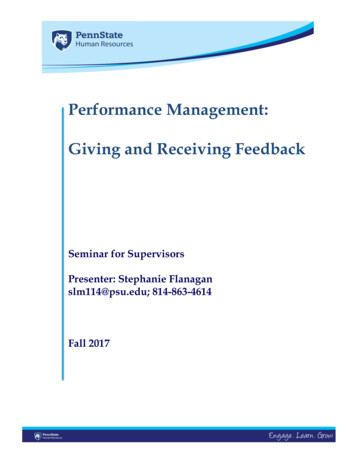
Transcription
PerformanceCorvairsHow to Hotrod the Corvair Engine and ChassisSeth Emerson and Bill FisherTucson, Arizona
PublishersHoward FisherHelen FisherEditorHoward FisherCover DesignGary Smith, Performance DesignText Design and ProductionDoug GoeweyPublished byCalifornia Bill’s Automotive HandbooksP.O. Box 91858Tucson, AZ 10 1-931128-22-7ISBN-13 978-1-931128-22-3Ebook 978-1-931128-37-7 2013 Seth EmersonPrinted in the United States of AmericaPrinting 10 9 8 7 6 5 4 3 2 1Front Cover1966 Corsa silver coupe, photo by Ned Madsen, BushStadium, Indianapolis, Indiana, 2008.1965 Corsa engine compartment photo bySeth Emerson.Back CoverDave Edsinger’s #18 white and blue 1966 Yenko Stinger,photo by Rick Norris. Detroit, Michigan, 2007.Seth Emerson’s #46 yellow and black 1965 YenkoStinger, photo by Dito Milian, gotbluemilk.com.Motorsports Photography. Thunderhill Raceway,Willows, California, 2012.John Egerton’s #6 white 1964 Monza, photo by RickNorris. Detroit, Michigan, 2007.Seth Emerson with Corvair-powered Lola T320, photoby Silicon Valley Corsa, Oakland, California, 1993.Title PageSeth Emerson #46 1965 Yenko Stinger, photo byDito Milian, gotbluemilk.com. MotorsportsPhotography. Thunderhill Raceway, Willows,California, 2012.Corvair Society of AmericaCORSA is a world-wide organization with 4,800members and 125 local chapters worldwide. Foundedin 1969, it is a large and enthusiastic group of automobile enthusiasts and one of the best single marque clubsin the world. The organization’s monthly magazine iscalled the CORSA Communique, www.corvair.orgAll rights reserved. No part of this book may be reproduced or transmitted in any form or by any means,electronic or mechanical, including photocopy, recording or any information storage and retrieval system,without written permission from the publisher, exceptby a reviewer who may quote brief passages in a review.Notice: The information in this book is true andcomplete to the best of our knowledge. It is offeredwithout guarantees on the part of the author orCalifornia Bill’s Automotive Handbooks. The authorand publisher disclaim all liability in connection withthe use of this book.
Table of ContentsAbout the Authors / Acknowledgments. . . . . . . . . . . . . . . . . . . . . . . . . . . . . . . . . . . . . . . . . . . . . . . . . . . . . . . . . . ivIntroduction. . . . . . . . . . . . . . . . . . . . . . . . . . . . . . . . . . . . . . . . . . . . . . . . . . . . . . . . . . . . . . . . . . . . . . . . . . . . . . . . . . . . . . . . . . . vii1An Unusual Automobile —Yearly Changes. . . . . . . . . . . . . . . . . . . . . . . . . . . . . . . . . . . . . . . . . . . . . . . . . . . . . . . 12Measuring Horsepower, Performance Theory, and Tradeoffs. . . . . . . . . . . . . . . . . . . . . . . . . . . . . . . . . 113Carburetion and Fuel Systems. . . . . . . . . . . . . . . . . . . . . . . . . . . . . . . . . . . . . . . . . . . . . . . . . . . . . . . . . . . . . . . . . . . . . . 174Ignition. . . . . . . . . . . . . . . . . . . . . . . . . . . . . . . . . . . . . . . . . . . . . . . . . . . . . . . . . . . . . . . . . . . . . . . . . . . . . . . . . . . . . . . . . . . . . . . . . 335Exhaust. . . . . . . . . . . . . . . . . . . . . . . . . . . . . . . . . . . . . . . . . . . . . . . . . . . . . . . . . . . . . . . . . . . . . . . . . . . . . . . . . . . . . . . . . . . . . . . . . 386Cylinder Heads. . . . . . . . . . . . . . . . . . . . . . . . . . . . . . . . . . . . . . . . . . . . . . . . . . . . . . . . . . . . . . . . . . . . . . . . . . . . . . . . . . . . . . . . 417Camshafts and Valve Train Basics. . . . . . . . . . . . . . . . . . . . . . . . . . . . . . . . . . . . . . . . . . . . . . . . . . . . . . . . . . . . . . . . . 508Pistons, Pins, and Rings. . . . . . . . . . . . . . . . . . . . . . . . . . . . . . . . . . . . . . . . . . . . . . . . . . . . . . . . . . . . . . . . . . . . . . . . . . . . . . 589Cylinders and Boring. . . . . . . . . . . . . . . . . . . . . . . . . . . . . . . . . . . . . . . . . . . . . . . . . . . . . . . . . . . . . . . . . . . . . . . . . . . . . . . . 6510Lower End. . . . . . . . . . . . . . . . . . . . . . . . . . . . . . . . . . . . . . . . . . . . . . . . . . . . . . . . . . . . . . . . . . . . . . . . . . . . . . . . . . . . . . . . . . . . . . 6711Engine Assembly. . . . . . . . . . . . . . . . . . . . . . . . . . . . . . . . . . . . . . . . . . . . . . . . . . . . . . . . . . . . . . . . . . . . . . . . . . . . . . . . . . . . . . 7312Lubrication, Cooling, and Breathing. . . . . . . . . . . . . . . . . . . . . . . . . . . . . . . . . . . . . . . . . . . . . . . . . . . . . . . . . . . . . . 8313Clutch and Flywheel. . . . . . . . . . . . . . . . . . . . . . . . . . . . . . . . . . . . . . . . . . . . . . . . . . . . . . . . . . . . . . . . . . . . . . . . . . . . . . . . . . 9714Transmissions, Gearing, and Axle Ratios. . . . . . . . . . . . . . . . . . . . . . . . . . . . . . . . . . . . . . . . . . . . . . . . . . . . . . . 10015Tuning. . . . . . . . . . . . . . . . . . . . . . . . . . . . . . . . . . . . . . . . . . . . . . . . . . . . . . . . . . . . . . . . . . . . . . . . . . . . . . . . . . . . . . . . . . . . . . . . 10316Spyders and Other Turbocharged Corvairs. . . . . . . . . . . . . . . . . . . . . . . . . . . . . . . . . . . . . . . . . . . . . . . . . . . . 10617Making It Handle. . . . . . . . . . . . . . . . . . . . . . . . . . . . . . . . . . . . . . . . . . . . . . . . . . . . . . . . . . . . . . . . . . . . . . . . . . . . . . . . . . . 11518Brakes, Wheels, and Tires. . . . . . . . . . . . . . . . . . . . . . . . . . . . . . . . . . . . . . . . . . . . . . . . . . . . . . . . . . . . . . . . . . . . . . . . . 12719Corvair Engines in Dune Buggies, Porsches, and Volkswagens. . . . . . . . . . . . . . . . . . . . . . . . . . . . 13520V8 and Other Engine-Swap Corvairs. . . . . . . . . . . . . . . . . . . . . . . . . . . . . . . . . . . . . . . . . . . . . . . . . . . . . . . . . . . 14521Interior Modifications. . . . . . . . . . . . . . . . . . . . . . . . . . . . . . . . . . . . . . . . . . . . . . . . . . . . . . . . . . . . . . . . . . . . . . . . . . . . . . 14922Cars Gallery. . . . . . . . . . . . . . . . . . . . . . . . . . . . . . . . . . . . . . . . . . . . . . . . . . . . . . . . . . . . . . . . . . . . . . . . . . . . . . . . . . . . . . . . . . 153Resources. . . . . . . . . . . . . . . . . . . . . . . . . . . . . . . . . . . . . . . . . . . . . . . . . . . . . . . . . . . . . . . . . . . . . . . . . . . . . . . . . . . . . . . . . . . . . 167
About the AuthorBill FisherAuthor Bill Fisher got involved with cars early on.His grandfather owned Chevrolet agencies in Illinois and from age six he played behind the garagestringing old auto batteries together to producemore power.His publishing career began in 1947 whilepursuing a master’s degree in education at theUniversity of Southern California. As it came timeto write his Master’s thesis, he decided to combinehis love of automobiles and English. He wroteHow to Construct a Hot Rod for High School AutoShop Classes. This thesis was the basis of his firstpublished automobile book. Later, in 1948, he hada speed equipment shop in Eagle Rock, Californiaand supplied speed parts to racers competing atBonneville, El Mirage, and Muroc Dry Lakes. Thiswas in addition to his flourishing mail-order automotive book business. Parts as well as books weresold to hot rodding enthusiasts across the country.Bill was a huge fan of Chevrolet inline sixcylinder engines and when the Corvair came out inan opposed-six configuration he dug in to learn allhe could.In 1963, he founded HP Books (HP for horsepower) and authored the original How to HotrodCorvair Engines in 1964, revising it twice by 1969.He loved motorcycles and cars. He rode them,tuned them, hot rodded, and raced them at thedry lakes. In 1981 he became a member of theBonneville 200 Mile Club, breaking a record inhis C Coupe at the Bonneville Salt Flats.AcknowledgmentsBill Fisher passed away in May, 1999. These are hisacknowledgments from the 1969 Revision III ofHow to Hotrod Corvair Engines.No book of this type is ever produced singlehandedly. I am deeply indebted to the many menand organizations who have been lavish in theirassistance, both in the writing of the original edition, and now in this revised version. The TechnicalProjects Department of Chevrolet Public Relations has provided outstanding help in answeringtechnical questions, and in providing technicalinformation and photographs that have been usedthroughout this book. Chevrolet’s MerchandisingDepartment has also been very helpful. GM policies prevent naming these gentlemen, but I ammost grateful to each of them.Over two years were spent in creating the original edition. This revised edition represents continuous digging and research into the use of Corvairssince the original was published. Encouragementfrom Frank McGurk of McGurk Engineeringand Jerry Light of Vic Hubbard Automotive wereespecially helpful in keeping the original projectunderway. Three men have been especially helpfulin providing information on their competitionexperiences with Corvairs: Don Eichstadt, DougRoe, and Ted Trevor. They have helped me to makethis revised version better in dozens of details.Special thanks is due to several friends: AngusMcDonald for the original cover design, John Jossfor editing advice, and C.E. Camp for invaluabletechnical advice on various aspects of mechanicalengineering relating to high-performance engines.– iv –
About the AuthorSeth EmersonI bought my first Corvair in 1967, after explodinga clutch in my latest/last 1955 Chevy. My parentsokayed a “Chevrolet OK Used Car” purchase, andeven co-signed for the loan, as long as it wasn’t a’55 Chevy. They figured it was so different than theother cars I had been modifying that I would leaveit alone and concentrate on college instead. Sorry,Mom! I think I stopped in and bought an IECOcatalog on the way home! In the last 45 years, I haveraced Corvairs in every type and class of racing inwhich they run (except off-road racing), includingSCCA autocross and road racing, drag racing, andrallying. I have driven Corvairs as street cars formany years, though not as my only car. My Corsaconvertible still has the engine that my girlfriendhelped me build. I am so thankful that I marriedher, 40 years ago. In the late ’70s, I respondedto friends’ laments about the poor quality ignition wires available for their race cars by startingSilicone Wire Systems. I have supplied thousandsof 8mm silicone ignition wire sets to most of theCorvair Parts vendors. I joined The Corvair Societyof America (CORSA) in 1973, just missing the Anaheim, California, convention. By 1980, I was fullyengaged and I haven’t missed a CORSA conventionsince. I was a Corsa director for more than fifteenyears and President of Corsa twice. I have drivenCorvairs to FTD trophies at conventions and placeda car into Senior Division Concours status as well.In short I have lived the Corvair life deeply over thepast 45 years. I don’t plan on stopping soon. And Iwill continue to research new ways of applying technology to our older cars. Why don’t you join me?AcknowledgmentsAs Bill Fisher said many years ago, a book like thiscannot be produced by one person. First Bill andthen Howard Fisher supported my efforts in theupdate. Bob Helt and Richard Finch, both prolificCorvair authors, also encouraged me to completethe work. A big thank you goes out to those whoare still building Corvair race cars and puttingthem on the track in front of an often skepticalpublic. The Corvair hasn’t quite outlasted all of itscritics, but it is well on its way to doing just that.Every time a Corvair puts the hurt on anothercar at the track, at the autocross, or even on thestreet(!), it validates Ed Cole’s concept, Bob Benzinger and Maurice Olley’s design, and countlessCorvair developers from Bill Thomas to Doug Roeto Don Yenko to John Fitch.To my Corvair friends, Bob Coffin, Chuck Sadek,Dave Edsinger, Rick Norris, Jim Schardt, EddieMeadows, Warren LeVeque and a dozen others, yourperseverance has always been my inspiration. Notonly did you share your hot rodding techniques, youshared your cars with me at the track. I cannot thankyou all enough, this is about the best I can do. Mywife, of course, put up with my endless Corsa events,track trips, hours in the garage, and various amountsof money stuffed into Corvairs and “parts.” ThanksBarbara, and thanks to you all. I hope you enjoyreading the book as much as I enjoyed writing it.–v–
IntroductionThe original How to Hotrod Corvair Engines(HTHCE) book was released in 1964.“California Bill” Fisher, a long time hot rodder andauthor had been enamored with the Corvair forsome time. (Undoubtedly through his friendshipwith Ted Trevor, owner of Crown Manufacturing.)Bill had completed an engine swap of a Corvairmotor into his Porsche 356 and was about to buyand drive a 1966 Corvair as his daily driver. Thecompany that released HTHCE was called HPBooks. The Corvair book was HP Book numberone. The success of that book spawned a publishing empire that went on to publish hundreds ofdifferent high performance automotive titles,created a crockery cookbook series, and finallyevery other type of book for do-it-yourselfers.Ownership of the company, HP Books, changedhands a few times, but Bill, along with his wife,Helen; and son, Howard; continued to releasebooks on varying subjects, including cars and carperformance. The last revised issue of HTHCE,done in about 1973, was reprinted a few timesby Corvair vendors, and hasn’t been available formany years, except at swap meets. Back in about1993, Bill and I agreed that a new revision of thebook was needed. Because I was eager to write andhe was busy with other projects, we agreed thatI would update and rewrite the book, gatheringin 20 more years of experience. The 20 years ofexperience has turned into 35, as other activities,both Corvair and otherwise, displaced much of mywriting time. Progress was being made, however.And at the time of Bill’s death in 1999, HowardFisher, his son, and I agreed that I should continuethe effort.Ironically, the Corvair, for a car 50 plus yearssince first production, is still inspiring authorsto produce books about it. As the cars age,authenticity becomes harder to achieve andpreserve. When it debuted, the original HTHCEwas the only book about Corvairs and the bookcovered the year-to-year differences in detail, atleast from the performance point of view. Since thattime, many books have been released to documentwhat Chevrolet produced and how they went aboutbuilding the cars. In this latest book, much ofthat authenticity data has been minimized, unlessneeded to indicate parts differences or sources. Inshort welcome to Performance Corvairs—How toHotrod the Corvair Engine and Chassis.– vii –
12Lubrication, Cooling,and BreathingEverything you do to increaseCorvair power increases theproduction of heat simultaneously.To maintain engine temperatures atusable levels requires increasing cooling abilities while accomplishing othermodifications. Because oil is used as anessential element in eliminating heatfrom the Corvair engine, lubricationhas been discussed in this chapter asinseparable from air and oil cooling.You cannot, except at great expense,increase the cooling-fin surface of thecylinders or heads. General Motorscarefully engineered these items toprovide maximum heat removal fromthe available cooling air consistent withthe limitations of modern volumeproduction techniques.You can greatly improve coolingby changing to a folded aluminum fincooler 1960 to 1962 Corvair part, aslong as you are a regular at keepingthe area clean. The 12-plate coolerintroduced on the last Spyder and carried on for all high-performance use,probably cools as well as the earlier,smaller folded-fin cooler, but is muchless likely to get plugged up with debris.Some additional help can be supplied by improving the heat-radiatingcharacteristics of the engine’s cast-ironand aluminum surfaces, both finnedand otherwise. A little improvement ispossible through exchanging certainof the sheet metal parts for finnedaluminum components. Added coolingis also available through better use ofthe oil’s heat-removal characteristicsvia increased flow made possiblethrough bearing and oil-pump modifications. Adequate crankcase breathing is also important to keep engineLubrication-system changes are essential for engine life when building a racing engine.This chapter tells why the changes are needed and how to make them.temperatures at reasonable levels. Allof the foregoing modifications are fullydescribed in this chapter.Chevrolet improved fan-belt life bychanging to a magnesium blower fan(1964), but the lesser inertia of this newcomponent didn’t help belt-loss problems very much. The added belt guidesdid help. Information is provided oninstalling the magnesium blower andperhaps more importantly, minor idlerpulley improvements to ensure beltretention. Details of the pros and consof changing blower speed through useof special pulleys are additional featuresof this chapter.No matter what you do to helpthe fan belt installation and coolingperformance, you need to pay attention to the belt. No matter how muchcare you take in pulley alignment, beltlubrication and maintenance, you willeventually throw a belt. The first indication you will see is the temp-press light
84 Chapter 12coming on as the alternator is no longercharging. If you are “enthusiastically”driving the car, you will probably feelthe few extra horsepower that you haveat your foot’s disposal, since you are notspinning the fan. There is a new indicator kit available that will tell you almostimmediately if the belt comes off andcooling air pressure has dropped offabove the motor. Levair Performanceis selling a kit that reads the pressurein the upper shroud and turns on awarning light if the pressure dropsbelow a safe threshold. If the belt comesoff at an inopportune time, you mightonly have a minute until the high headtemps convince the valve seats to leave.CORVAIR ROAD LOAD COOLINGStock Cooling SystemAlthough it might appear that the Corvair is the same yesterday, today, andtomorrow, nothing could be fartherfrom the truth regarding its coolingsystem. Detailed changes that havebeen made deserve your careful consideration and understanding.The Corvair uses forced-air cooling. Engine enclosure by sheet metalshrouding directs air over the cylinderheads, cylinders, and oil cooler. Thermostatic cooling control is provided on1961 and later engines by bellows-controlled damper doors at each side of theengine. These doors open when temperature of the air under the cylindersattains 205 F. Thus, even on cold days,the engine is operated as if it were in anambient temperature of approximately80 F. An engine blower fan is mountedhorizontally atop the engine. It is beltdriven at 1.58 times engine speed. 1960models differ in that cooling air is controlled by a thermostatically controlledring on the blower-fan inlet.How Hot Is the Engine Getting?The factory keeps you in the dark onthis question, at least when you aredriving the car. Nothing warns youof an overheat condition except aninstrument-panel light which illuminates in the event of low oil pressureor an overheat condition sensed atone cylinder head. Oil temperatureis neither measured nor indicated.Although cylinder-head overheat isindicated immediately by the light, oilpressure indication is far too slow. Bythe time the light comes on the damagehas probably already occurred. For thisreason an oil-pressure gauge should beconsidered even more important thanthe cylinder-head and oil-temperaturegauges or warnings which are detailedherein. It should be mentioned thatthe Spyder head temperature circuitincludes a buzzer to “sound off ” andprovide an insistent indication that itis time to “back off.” This feature wascarried on for the Corsa model, whenturbo equipped. On non-turbos, thewiring is still there, they just left thebuzzer out. The Temp-Press indicatorlights up simultaneously on the dash.The importance of knowing moreabout temperatures in a modified engineis stressed by the following curves anddescription for the original SAE Paper140C, “The Chevrolet Corvair.”“An air-cooled engine is operatedover a considerable temperature rangeunder normal operation. From 20miles an hour at road-load conditionsto maximum speed, the cylinder-headtemperature increases from about 300to 435 degrees. This represents theworst road-load cooling condition: thesame temperature also prevails at lowerspeeds during full-throttle operation.The temperature characteristic curveof this engine follows quite closely afterthe indicated mean effective pressurecurve. The peak for our engine, occurring at about 2,600 RPM representsthe worst cooling conditions we canobtain—about 30 degrees hotter than atmaximum speed.”The foregoing statements relatedto the 80 HP engine as originallyintroduced and failed to mention thatoil temperature simultaneously soaredto 280 F, which is higher than can beconsidered safe. According to Mackerle,oil temperatures should be maintainedabove 176 F to keep down friction lossand dilution by gasoline, and shouldnot exceed 230 F for continuous operation. Up to 230 F may be consideredpermissible for short bursts.Measuring Cylinder HeadTemperaturesAll Spyders and the 1965–66 Corsamodels have cylinder head temperaturegauges operating from one cylinderhead. Like many low-production parts,these devices are quite high pricedshould you choose to build your ownfrom the stock parts, if they are available. You could install just the onegauge, but it would require a separatehousing, and the marked lens must bemounted in the housing that you fabricate. The harder part relates to removalof your standard cylinder heads and
Lubrication, Cooling, and Breathing 85machining an opening for the sender—that must match the one used in theTurbo 140 head, so you’ll need one ofthose for a sample. Several sources sellan adapter which lets you install thefine-threaded sender in place of theoriginal coarse-threaded unit. Perhapsa simpler method would be to changeto an aftermarket Cylinder Head Temp(CHT) gauge. They used to be commonly available from most gauge manufacturers, but since Porsche left the“air-cooled” scene, many of them havebeen dropped. VDO still sells an appropriate gauge. Westach Instruments inPetaluma, California, makes both asingle and a dual CHT gauge. Autometer still sells one, as long as your CHTwill never exceed 340 F. The GM gaugewas a “thermistor” based gauge, wherethe sending unit changed its resistanceto ground as the temperature rose. Allof the aftermarket gauges are “thermocouple” based, where a pair of wires ofdifferent metallurgy, crimped together,will actually send a small current downthe wire pair, when the junction is subjected to the change in heat. The gaugeon the dash is calibrated to show thatsmall current as a temperature reading.The aftermarket gauges come with amethod of installing the thermocoupleinto or onto the head. Many of themuse a ring under the sparkplug to carrythe thermocouple. The most accurateones use a thermocouple probe whichcan be placed in the original thermistorlocations, up inside the cylinder head.Be sure that the gauge will display arange of temperatures up to 600 F.A Chevy dealer bulletin advisedSpyder cylinder-head temperaturesas: 200 to 300 at idle; 350 to 475 at 30 to 60 MPH cruise; and 460 to575 from 3,000 to 5,000 RPM at fullthrottle. Overheat-warning switchesare used on all Corvair engines, andthese have changed as the factory hasupped the horsepower produced by theengine. The unit used on the Spyderand 140 HP engines operates at 575 F,but uses a 3/8 inch-24 thread insteadof the 3/8 inch-16 thread used on theother switches. ’60–’64 engines, if notoriginally supplied with air conditioning, can have a switch that operatessomewhere close to this 575 F temperature by installing Part No. 1993574(identified by grooves on the hex nut).Oil Temperature MeasurementWestberg Manufacturing makes Westachgauges, including this dual cylinder headtemp unit.This single head temp gauge makes a greatreplacement for the factory unit on theSpyder and Corsa.Oil temperature can be measured witha sending unit coupled to a gauge.Although all special oil pans include aboss for the addition of such a sender,the bottom of the oil sump gives afalse (too-cool or too-hot) reading thatcannot be relied on for accuracy. Thebest place to measure oil temperaturein the Corvair—as the oil leaves thecooler—is not easy to get to because therear accessory cover delivers the cooledoil directly to the main oil passages. Asecond-best choice for early enginesis to insert the temperature sender inthe right side of the block where thepressure sender was originally located.If this spot is used, an aluminum heatshield must be constructed for thesender. Later blocks have a boss nearthe cooler. This boss can be drilled andtapped for sender installation.Ford oil-temperature switch closes at 280 F,flashing panel light in warning when wiredas shown.If you merely want to be warnedwhen oil temperature reaches thedanger point, some small amount ofmoney will buy the system Ford useswith their 427s. The schematic diagramshows how to wire the parts to workwith your TEMP-PRESS warning light.When oil temperature rises above270 /– 48 F, the instrument-panelwarning light flashes on and off untiltemperature drops below that point.The low-pressure warning (2 to 6 psi)operates as it was intended to. Fordparts required are: oil temperature relayAutometer makes several different seriesof instruments, many of them resemble theoriginal GM-style gauges.
86 Chapter 12ClTFlOB840-A, oil-temperature flasherC3AZ9E296-A, and oil-temperaturesending unit C3AZlOB921-A. Thesender will require some specialmounting techniques.Pressure SwitchWhen your Corvair engine’s oil pressure drops to 2 to 6 psi, the oil-pressurewarning light tells you that youhave insufficient oil pressure. Racerssometimes call the original switch, the“Engine Destruct Indicator,” because itcomes on at such a low pressure, tellingyou why the motor just broke—youdid not have enough oil pressure.This inadequate warning system isthe primary reason for installing anoil-pressure gauge. 1960–62 pressureswitches failed and leaked frequentlydue to design and location in an areaof extreme heat in the air-exhaust duct.The switch was improved and relocated.Modify your ’60–’61 model to relocatethe new switch into the top of theoil-filter adapter. Use a six-point 1-1/16socket, not pliers or a 12-point socketor you will distort the switch, causingquick failure.Oil Pressure Gauge Choices—Electric versus MechanicalInstallation of an electrical-type gaugeis comparatively easy, as it is only necessary to mount the stock oil-pressureswitch with the pressure sender ontoa tee. It is important to keep the oilpressure switch and warning light inthe system. You might just be looking the other way when the oil filterbolt falls out. The light will draw yourattention. It is safer, and therefore moredesirable, to measure the pressure ata point more remote from the pumpoutput, such as at the main oil gallery.The tapped hole on the right side ofthe block where the oil-level gaugetube enters the block connects directlyinto one main oil gallery. Measuringpressure nearer the pump outlet maynot disclose a blocked oil gallery, butthat is pretty rare. Should you chooseto use the remote location for thepressure-measuring point, then thesender should not be mounted directlyonto the block below the cylinders.The first Corvairs (’60 and ’61) sufferedfrom pressure switch failure due tohigh ambient temperatures and thislocation was abandoned in favor ofplacing the switch by the generator. A45-degree elbow can be screwed intothe boss and a copper tube used tocarry the oil to the pressure switch thatcan be bracket supported just atop thecenter of cylinders 1 and 3. Take carenot to obstruct the airflow, of course.Mechanical pressure gauges, even withthe long pressure tubes needed whenlocating the actual gauge at the dash,used to be preferred to the mechanicalgauges, because the electrical ones werelimited to a 90-degree movement. Themechanical pointer could sweep about270 degrees, giving finer definition ofthe temps. Newer electric gauges, nowwith internal stepper motors, can sweepthe larger area.Gauge InstallationsIf you are preparing an early modelthat didn’t start out as a Spyder, youcan switch to the Spyder dash and theinstrument feeds to provide the data.That will present you with a few extragauges. But you will still be missing anoil pressure and oil temp gauge. A smallpanel underneath the radio will provideyou with room for three extra gauges.I suggest an oil pressure, an oil temp,and a voltmeter. Late models can addgauges in the dash above the radio, evenangling them toward the driver. But ifyou start with the Corsa dash, you canadd several gauges in the dash itself,without sawing new holes or addingmounting plates underneath, maintaining that “stock” look. If you are not running a turbo, you can dump the vacuumgauge along with the small clock thathasn’t worked since the Carter administration. You can replace the lame Corsatachometer and even install a GPSenabled speedometer if you wish. Nowon the market is a set of four mountingplates that attach to the back side of theCorsa dash, using the original mounting holes. The plates retain the standardaftermarket gauges of your choice,four in the middle, 2-1/16" gauges, andtwo on the side, 3-3/8" gauges. The lateCorvair used the standard 0-90 ohmfuel level sender and all the gaugemanufacturers make compatible gauges.The plates are removable and the installation can be returned to stock if youchange your mind. See th
Photography. Thunderhill Raceway, Willows, California, 2012. Corvair Society of America CORSA is a world-wide organization with 4,800 members and 125 local chapters worldwide. Founded in 1969, it is a large and enthusiastic group of automo-bile enthusiasts and one of the best single

